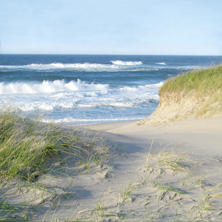photograph by Scott Coffen-Smout
DESIGN WITH A DYNAMIC ECOSYSTEM
SABLE ISLAND NATIONAL PARK
A dynamic ecosystem can be defined as one which naturally changes faster than its human settlements. Development in these ecosystems is often avoided because inevitable landscape changes are difficult to predict and not easily accommodated by traditional building methods and technologies. In cases like Sable Island National Park, infrastructure development in dynamic ecosystems is necessary and demands architecture designed to thrive in changing habitats.
DESIGN METHOD
This research proposes a method for designing architecture that can adapt to and participate in dynamic ecosystems.
It can be applied to any coastal, wetland, permafrost, desert or other dynamic environments that challenge conventional building methods. With careful study, interpretation, and accommodation of natural processes, design can propose strategies for people to participate in the world’s fragile and dynamic ecosystems.

To design with a dynamic ecosystem requires:
1 Learning from ecosystems
Instead of just studying a place for site characteristics, one must study an ecosystem to understand site dynamics.
2 Extracting principles
Understanding site dynamics provides a set of architectural guidelines for intervention in that place.
3 Defining processes for adaptation
One must recognize that architecture is not timeless, and therefore need the ability to adapt to their changing habitat.
Design work should not end with construction; observing the ecosystem's interactions with the new architecture throughout its lifespan will reveal potential for further innovation and change. Like any non-native organism introduced to an ecosystem, the architecture can evolve over its generations until it is considered endemic.
Sable Island National Park is an ideal case study to test this method because its simple and dynamic ecosystem defines clear guidelines and requirements for adaptation.





